In Vitro Structural Characteristics and Antioxidant and Expectorant Activities of Polysaccharides from Citri grandis fructus immaturus
Abstract
1. Introduction
2. Materials and Methods
2.1. Materials and Reagents
2.2. Extraction and Purification of ECP (Citri grandis fructus immaturus Polysaccharides)
2.3. Characterization Analysis of Polysaccharides
2.3.1. Triple Helix Structure Analysis
2.3.2. Monosaccharide Composition Analysis
2.3.3. Periodate Oxidation and Smith Degradation Analysis
2.3.4. Mw Determination
2.3.5. FT-IR Spectra
2.3.6. Scanning Electron Microscopy (SEM)
2.4. Determination of Antioxidant Activity
2.4.1. Assay of ABTS Radical Scavenging Activity
2.4.2. Impact of Polysaccharides on FRAP Oxidation Reactions
2.5. Measurement of Expectorant Activity
2.5.1. Cell Viability Assay
2.5.2. Measurement of MUC5AC Mucin Content
2.6. Data Analysis
3. Results
3.1. Extraction and Purification of Polysaccharides
3.2. Chemical Composition
3.3. Characterization of Polysaccharides
3.3.1. Triple Helix Structure
3.3.2. Monosaccharide Composition
3.3.3. Periodate Oxidation and Smith Degradation
3.3.4. Mw
3.3.5. FT-IR
3.3.6. SEM
3.4. Antioxidant Activity
3.4.1. ABTS Radical Scavenging Activity
3.4.2. Effect of Polysaccharides on FRAP Oxidation Reactions
3.5. Expectorant Activity
3.5.1. Cell Viability
3.5.2. MUC5AC Mucin Content
3.6. Correlation Analysis
4. Discussion
5. Conclusions
Author Contributions
Funding
Institutional Review Board Statement
Informed Consent Statement
Data Availability Statement
Acknowledgments
Conflicts of Interest
Abbreviations
| BCA | bicinchoninic acid |
| CSE | cigarette smoke extract |
| DEAE | diethylaminoethyl |
| DMEM | Dulbecco’s modified eagle medium |
| DMSO | dimethyl sulfoxide |
| ECP | Citri grandis fructus immaturus polysaccharides |
| FRAP | ferric ion-reducing antioxidant power |
| FT-IR | Fourier transform infrared |
| GC-MS | gas chromatography-mass spectrometry |
| HPGPC | high-performance gel permeation chromatography |
| HPLC | high-performance liquid chromatograph |
| LPS | lipopolysaccharide |
| MTT | methylthiazolyldiphenyl-tetrazolium bromide |
| Mw | molecular weight |
| PBS | Phosphate-buffered saline |
| SEM | scanning electron microscopy |
| TFA | trifluoroacetic acid |
References
- Shuyan, X.; Qinhui, Y.; Jinghua, Y.; Shanshan, F.; Yong, Y.; Rong, R. Research progress on antitumor effect of marine polysaccharides. Chin. Arch. Trad. Chin. Med. 2021, 39, 158–161. [Google Scholar]
- Zhe, Y.; Danzhao, C.; Hongtao, C. Research progress on antitumor mechanism of polysaccharide. Chin. Mod. Med. 2021, 28, 30–34. [Google Scholar]
- Mingwei, Z.; Fei, H.; Ruifen, Z. Immunomodulatory effect and mechanism of fruit and vegetable polysaccharides. J. Chin. Inst. Food Sci. Technol. 2021, 21, 1–13. [Google Scholar]
- Shanglin, H. Study Hypolipidemic Act. Crude Polysaccharide Xizang Auricularia Auriculata. Master’s Thesis, Agriculture and Animal Husbandry College of Tibet University, Linzhi, China, 2021. [Google Scholar]
- Xiaoyue, K. Study on Hypolipidemic Activity and Liposomal Formulation of Pueraria Lobata Polysaccharides; Jiangsu University: Zhenjiang, China, 2019. [Google Scholar]
- Liu, X.L.; Zhao, Y.C.; Chen, X.Y.; She, X.X.; Sadia, K.; Jiang, Y.; Xie, H.Y.; Jiang, B.N.; Zheng, Y.A.; Liu, W.C.; et al. Antifatigue effect and molecular mechanism of black ginseng polysaccharides in mice. Food Sci. 2020, 41, 173–179. [Google Scholar]
- Shang, T.T.; Li, T.; Zhou, J.; Huang, X. Advances in research on structure-activity relationship of plant polysaccharides. Guangdong Chem. Ind. 2019, 46, 99–100. [Google Scholar]
- Li, P.; Peng, W.; Wu, H.; Wang, Y.; Li, P.; Zhang, M.; Su, W. Suggestions for the quality standard in Chinese pharmacopoeia of Citri Grandis Exocarpium and the establishment of its grade standard. Acta Sci. Nat. Univ. Sunyatseni 2019, 58, 1–13. [Google Scholar]
- Gao, Z.; Zhang, X.; Mai, B.; Lin, X.; Fang, J.; Zhong, J.; Zhan, R.; Xiao, F. Analysis of quality difference of different specifications and different origins of Citri Grandis Exocarpium. China Pharm. 2022, 33, 825–829. [Google Scholar]
- Qingyuan, C.; Mingtao, Z.; Hanwu, D.; Bingfu, L. Development status and quality control prospect of GenuineExocarpium Citri Grandis industry. Guangzhou Chem. Ind. 2021, 49, 33–37. [Google Scholar]
- Zeng, X.; Su, W.; Zheng, Y.; Liu, H.; Li, P.; Zhang, W.; Liang, Y.; Bai, Y.; Peng, W.; Yao, H. UFLC-Q-TOF-MS/MS-based screening and identification of flavonoids and derived metabolites in human urine after oral administration of exocarpium Citri Grandis extract. Molecules 2018, 23, 895. [Google Scholar] [CrossRef]
- Yanhui, W. Research progress of Citri Grandis exocarpium. Modernization of traditional Chinese medicine and materia medica-world. Sci. Technol. 2017, 19, 1076–1082. [Google Scholar]
- Xiu-juan, H.; Yong-gen, S.; Ming-sheng, X.; Shao-wu, F.A.N.; Liang, H. Dephlogisticate, antitussive and expectorant effects of polysaccharides from exocarpium citri grandis on mice. Mod. Food Sci. Technol. 2013, 29, 1227–1229+1206. [Google Scholar]
- Le-hui, Y. Study on antioxidant capacity and antifatigue effect of exocarpium citri grandis polysaccharides. Cereals Oils 2019, 32, 95–100. [Google Scholar]
- Zhong, F.F.; Yan, M.G.; Guo, J.J.; Zhu, G.; Yin, W.B. The protective effect and mechanism of citri grandis exocarpium polysaccharide on Aβ25~35 induced Alzheimer’s disease in mice. J. Trop. Med. 2019, 19, 1480–14841601. [Google Scholar]
- Zhipeng, S. Comprehensive Utilization, Antidiabetic and Lipid-Lowering Activity of the Active Ingredient from the Exocarpium citri Grandis; Guangdong Pharmaceutical University: Guangzhou, China, 2019. [Google Scholar]
- Zhou, B.W. Medicinal use of polysaccharide of exocarpium citri rubrum. Chin. Pharm. J. 1993, 28, 135–136, 187. [Google Scholar]
- Cheng, H.F.; Li, X.F.; Dongye, G.Z. Study on chemistry and antioxidative activity of water soluble polysaccharide of Exocarpium Citri Grandis. Chem. World 2002, 2, 84. [Google Scholar]
- Miherenisha, A.; Mu-Re-Jiang, H.; Sheng, R.; Guo-Rui, H.; Tao-Er-Da-Hong, Y.; Fei, Y. Separation and purification of acidic polysaccharide PSAP-1 from Pyrus sinkiangensis and its uronic acid content determination. J. Food Saf. Qual. 2022, 13, 7454–7460. [Google Scholar]
- Yue, F.; Zhang, J.; Xu, J.; Niu, T.; Lü, X.; Liu, M. Effects of monosaccharide composition on quantitative analysis of total sugar content by phenol-sulfuric acid method. Front. Nutr. 2022, 9, 963318. [Google Scholar] [CrossRef]
- You, L.J.; Zou, L.W.; Liang, Y.H.; Zhao, M.M. Characteristics of lentinan polysaccharide extracted by ultrasonic wave and hot water. Mod. Food Sci. Technol. 2013, 29, 2167–2172. [Google Scholar]
- Wang, Z.X.; Li, N.; Xu, J.W. Effects of efficient expression of Vitreoscilla hemoglobin on production, monosaccharide composition, and antioxidant activity of exopolysaccharides in Ganoderma lucidum. Microorganisms 2021, 9, 1551. [Google Scholar] [CrossRef]
- Liu, D.; Tang, W.; Yin, J.Y.; Nie, S.P.; Xie, M.Y. Monosaccharide composition analysis of polysaccharides from natural sources: Hydrolysis condition and detection method development. Food Hydrocoll. 2021, 116, 106641. [Google Scholar] [CrossRef]
- Huojiaaihemaiti, H.; Fang, L.C.; Ning, H.X.; Mutaillifu, P.; Abudukelimu, N.; Nuerxiati, R.; Lei, X.X.; Aisa, H.; Yili, A. Polysaccharides from fruit of Elaeagnus angustifolia and their antioxidant activity. Chem. Nat. Compd. 2022, 58, 991–994. [Google Scholar] [CrossRef]
- Kodiralieva, F.K.; Shashkov, A.S.; Rakhmanberdyeva, R.K. Structure of galactomannan from seeds of Crotalaria alata. Chem. Nat. Compd. 2015, 51, 405–408. [Google Scholar] [CrossRef]
- Rumpf, J.; Burger, R.; Schulze, M. Statistical evaluation of DPPH, ABTS, FRAP, and Folin-Ciocalteu assays to assess the antioxidant capacity of lignins. Int. J. Biol. Macromol. 2023, 233, 123470. [Google Scholar] [CrossRef]
- Egu, S.A.; Ali, I.; Khan, K.M.; Chigurupati, S.; Qureshi, U.; Salar, U.; Taha, M.; Felemban, S.G.; Venugopal, V.; Ul-Haq, Z. Syntheses, in vitro, and in silico studies of rhodanine-based Schiff bases as potential α-amylase inhibitors and radicals (DPPH and ABTS) scavengers. Mol. Divers. 2023, 27, 767–791. [Google Scholar] [CrossRef] [PubMed]
- Lorena, V.M.C.; Julia, C.D.A.; Hipólito, I.M.J. Comparison of DPPH free radical scavenging, ferric reducing antioxidant power (FRAP), and total phenolic content of two Meriania species (Melastomataceae). Rev. Cienc. 2018, 19, 117–124. [Google Scholar]
- Zheng, R.; Zhang, Y.; Yu, Q.; Li, B.; Xu, D.; Jiao, L.; Li, Y. Exaction, separation and activity of polysaccharides from Acanthopanax sessiliflorus. Pharmacol. Clin. Chin. Mater. Med. 2022, 38, 86–92. [Google Scholar]
- Wenjian, Y. Studies on Purification, Characterizations and Improving Learning and Memory Function of Flammulina velutipes Polysaccharide; Nanjing Agricultural University: Nanjing, China, 2012. [Google Scholar]
- Xie, C.; Gao, X.D.; Wang, J.; Liu, D.; Yao, W.B. Studies on dimensional structure and biological activity of Flammulina velutipes polysaccharides containing germanium. J. China Pharm. Univ. 2004, 06, 95–99. [Google Scholar]
- Li, X.; Li, K.; Qin, X.; Li, Z.; Fan, X.; Cui, L. Advances in structural analysis methods for polysaccharides. J. Shanxi Med. Univ. 2021, 52, 380–387. [Google Scholar]
- Guo, M.Z.; Meng, M.; Duan, S.Q.; Feng, C.C.; Wang, C.L. Structure characterization, physicochemical property and immunomodulatory activity on RAW264.7 cells of a novel triple-helix polysaccharide from Craterellus cornucopioides. Int. J. Biol. Macromol. 2019, 126, 796–804. [Google Scholar] [CrossRef] [PubMed]
- Zhang, D.; Li, S.; Xiong, Q.; Jiang, C.; Lai, X. Extraction, characterization and biological activities of polysaccharides from Amomum villosum. Carbohydr. Polym. 2013, 95, 114–122. [Google Scholar] [CrossRef] [PubMed]
- Liang, Z.; Yi, Y.; Guo, Y.; Wang, R.; Hu, Q.; Xiong, X. Chemical characterization and antitumor activities of polysaccharide extracted from Ganoderma lucidum. Int. J. Mol. Sci. 2014, 15, 9103–9116. [Google Scholar] [CrossRef]
- Luo, Q.L.; Tang, Z.H.; Zhang, X.F.; Zhong, Y.H.; Yao, S.Z.; Wang, L.S.; Lin, C.W.; Luo, X. Chemical properties and antioxidant activity of a water-soluble polysaccharide from Dendrobium officinale. Int. J. Biol. Macromol. 2016, 89, 219–227. [Google Scholar] [CrossRef] [PubMed]
- Ji, X.; Zhang, F.; Zhang, R.; Liu, F.; Peng, Q.; Wang, M. An acidic polysaccharide from Ziziphus Jujuba cv. muzao: Purification and structural characterization. Food Chem. 2019, 274, 494–499. [Google Scholar] [CrossRef] [PubMed]
- Jia, X.; Ding, C.; Yuan, S.; Zhang, Z.; Chen, Y.; Du, L.; Yuan, M. Extraction, purification and characterization of polysaccharides from Hawk tea. Carbohydr. Polym. 2014, 99, 319–324. [Google Scholar] [CrossRef]
- Wang, Q.L. Activity Screening and Structure-Activity Relationship Research of Polysaccharides from Traditional Chinese Medicine via Immunoaffinity Chromatography; Jiangsu University: Zhenjiang, China, 2019. [Google Scholar]
- Que, F.; Tao, W.; Feng, W. Preparation and biological activities of low molecular weight Brown Algae. Food Ind. Sci. Technol. 2022, 43, 226–232. [Google Scholar]
- Ai, Y.J. Study on the Structure-Activity Relationship of Antioxidant Tea Polysaccharides; Huazhong Agricultural University: Wuhan, China, 2019. [Google Scholar]
- Zhou, S.Y.; Huang, G.L.; Long, R. Ultrasonic-assisted extraction, structural analysis and antioxidative mechanism of polysaccharide from sunflower disc. J. Mol. Struct. 2025, 1321, 140200. [Google Scholar] [CrossRef]
- Zhou, K. Structure Identification and Immunoregulatory Activity of Polysaccharide from Pyrus Sinkiangensis Yu and Its Mechanism of Anti Airway Inflammation; Xinjiang Medical University: Urumqi, China, 2020. [Google Scholar]
- Huang, C.; Peng, W.; Wei, D.N.; Zhong, Z.Q.; Mou, M.T.; Wei, S.J.; Gao, Y.X.; Wu, C.J. Effect of Pinelliae Rhizoma Praeparatum Cum Alumine polysaccharides on MUC5AC mRNA in lung tissues of allergic asthma model rats. Chin. J. Exp. Tradit. Med. 2019, 25, 15–21. [Google Scholar]

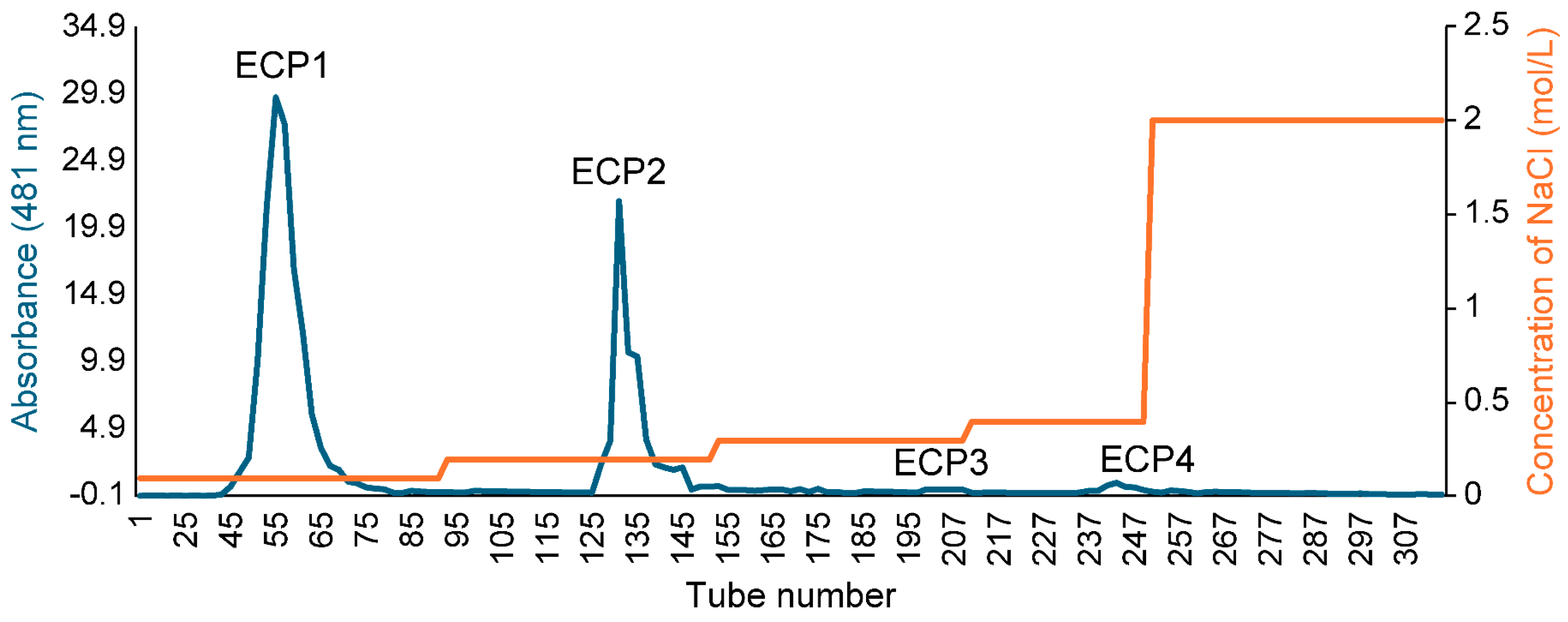
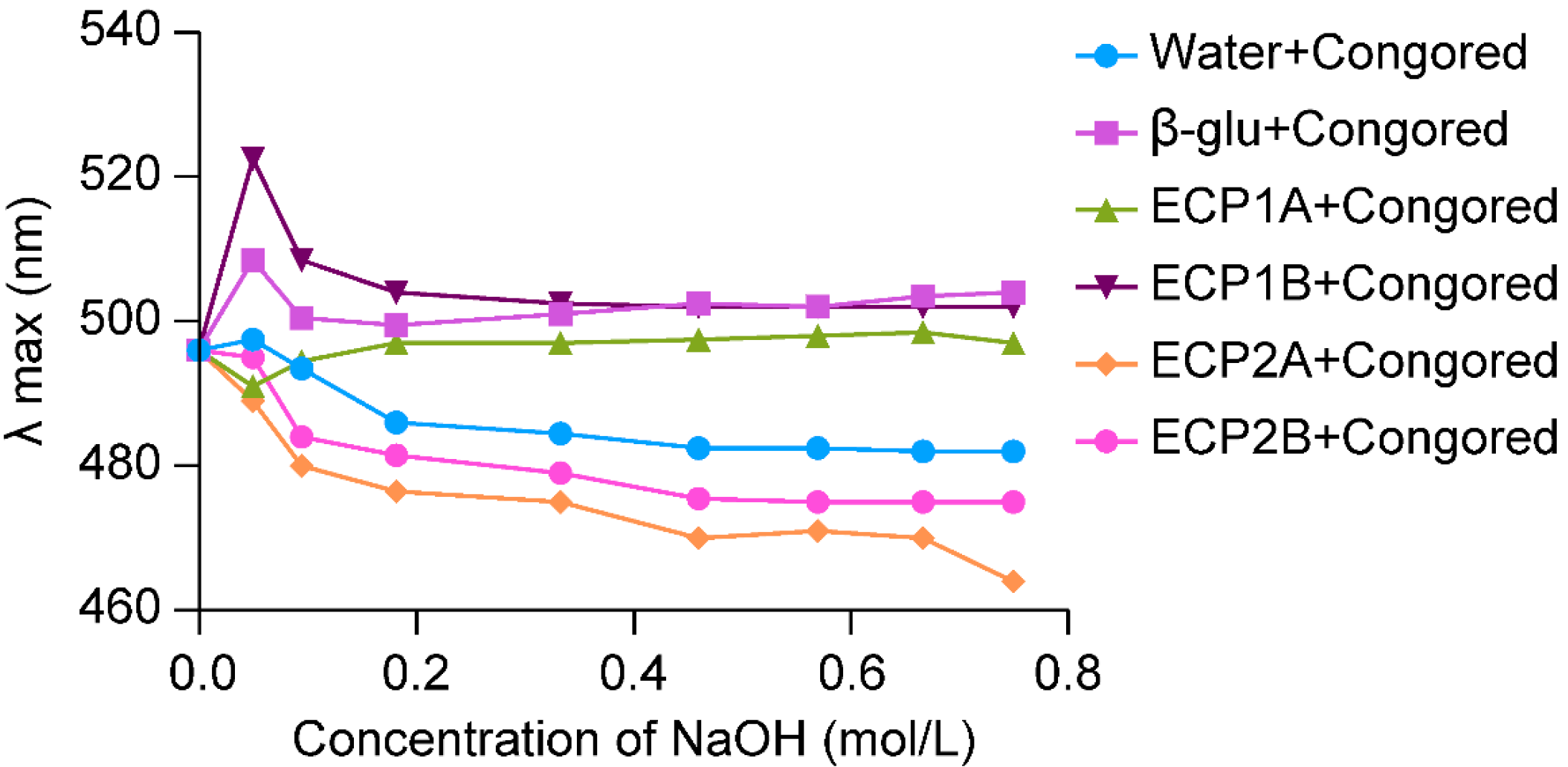
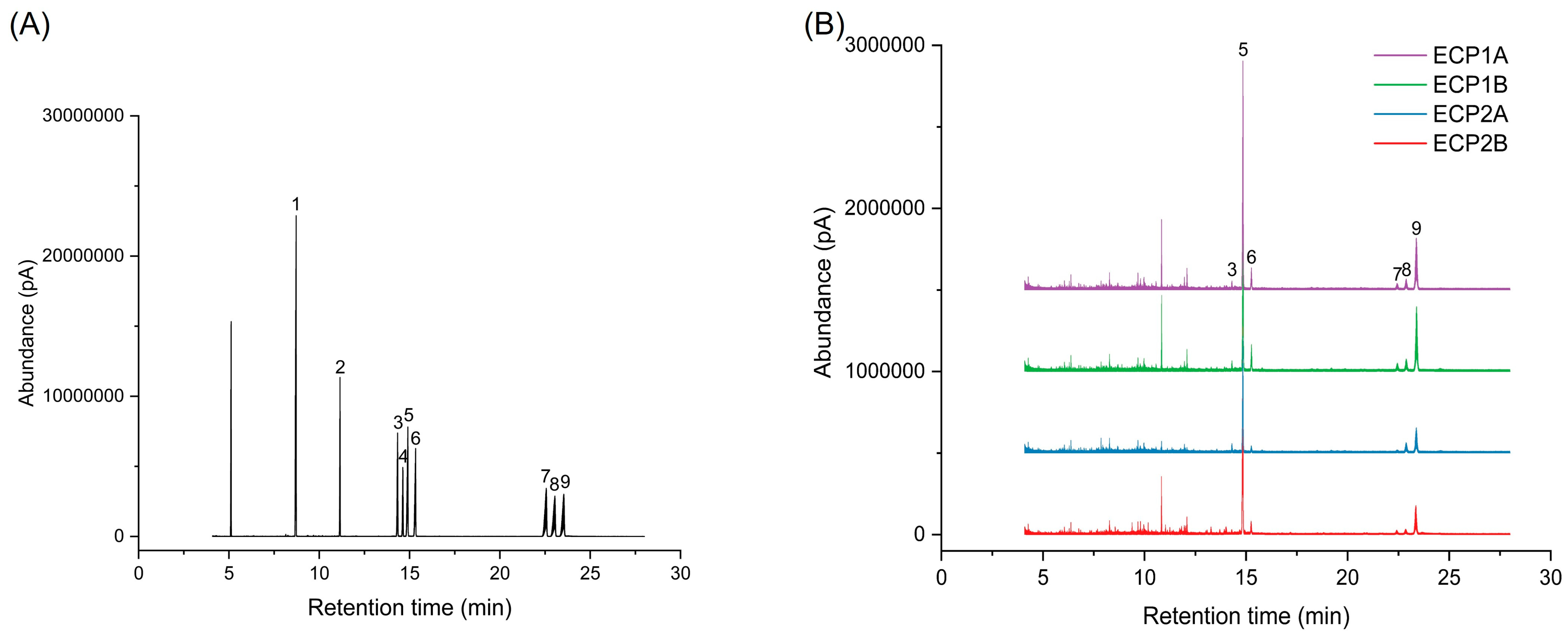

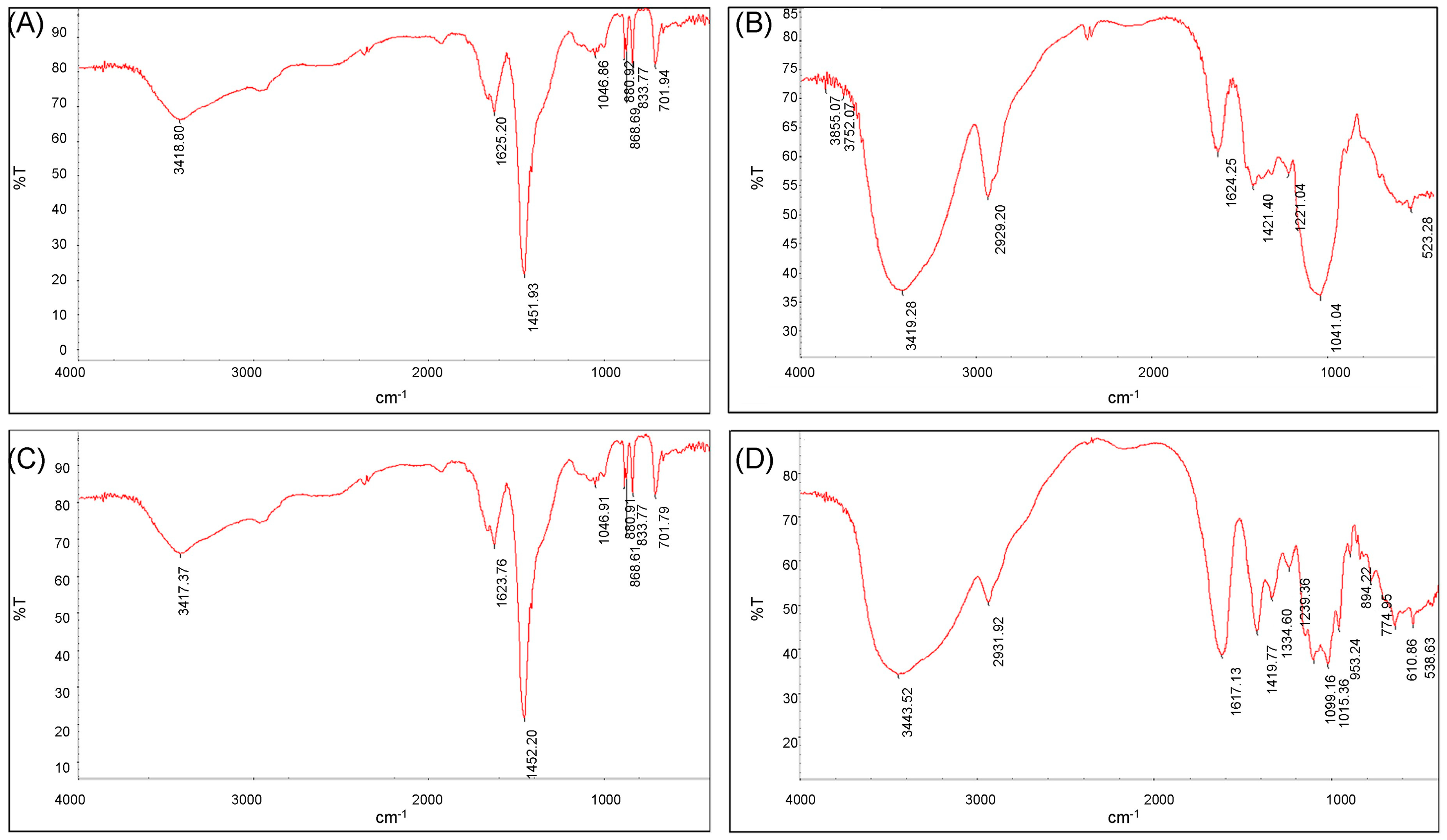
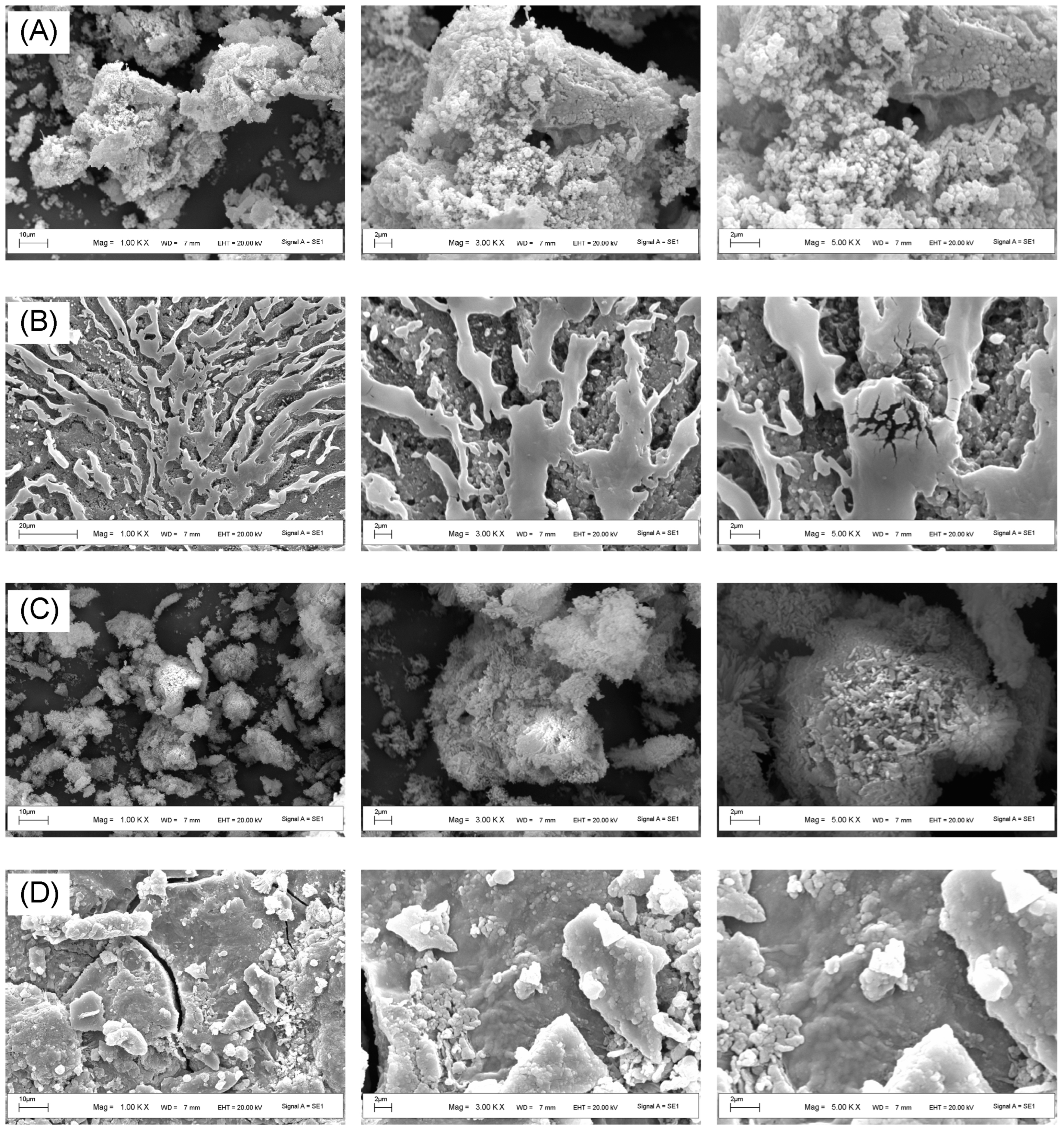




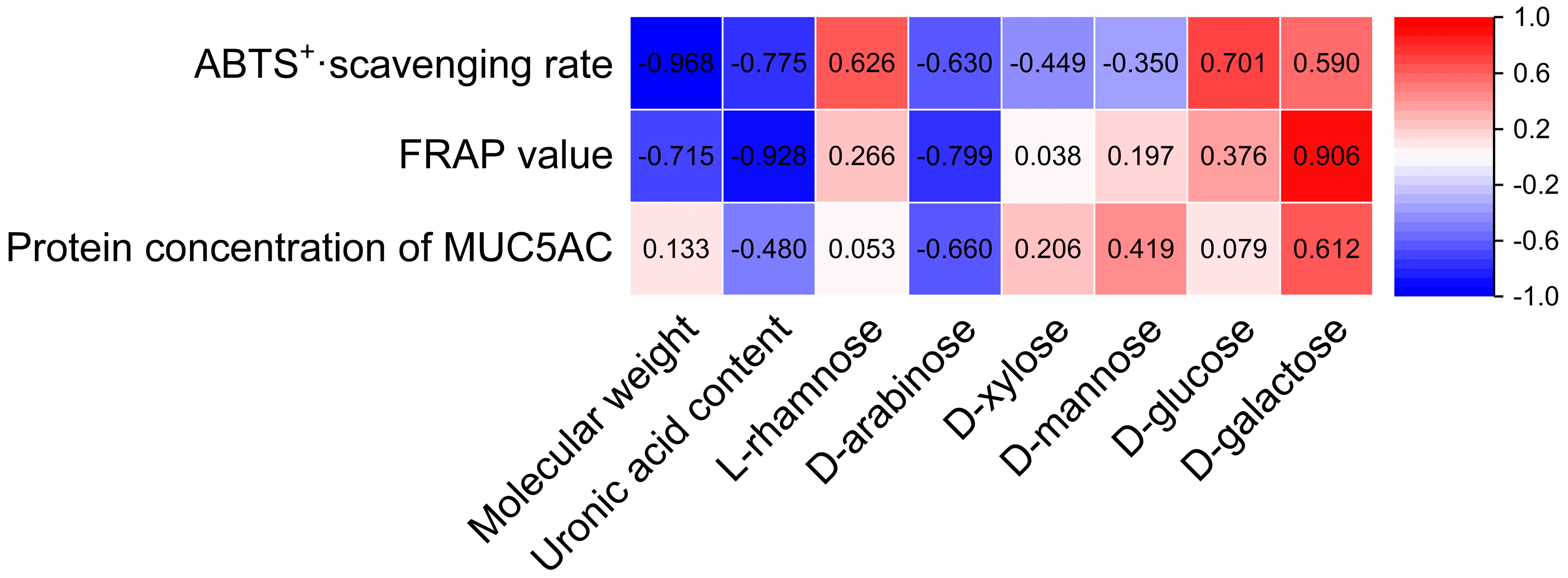
| Positive Control | Samples | Sample Blank Background | Working Liquid Background | |
|---|---|---|---|---|
| ABTS working liquid (μL) | 180 | 180 | 0 | 180 |
| 95% ethanol (μL) | 0 | 0 | 180 | 20 |
| Sample solutions (μL) | 0 | 20 | 20 | 0 |
| Positive solution (μL) | 20 | 0 | 0 | 0 |
| Positive Control | Samples | Sample Blank Background | Working Liquid Background | |
|---|---|---|---|---|
| FRAP working liquid (μL) | 180 | 180 | 0 | 180 |
| Distilled water (μL) | 0 | 0 | 180 | 20 |
| Sample solutions (μL) | 0 | 20 | 20 | 0 |
| Positive solution (μL) | 20 | 0 | 0 | 0 |
| ECP1A | ECP1B | ECP2A | ECP2B | |
|---|---|---|---|---|
| Protein (%) | 3.54 ± 0.15 | 3.14 ± 0.14 | 4.42 ± 0.24 | 15.23 ± 0.37 |
| Uronic acid (%) | 1.62 ± 0.00 | 3.65 ± 0.00 | 2.43 ± 0.00 | 13.51 ± 0.00 |
| Total sugar (%) | 5.85 ± 0.00 | 73.11 ± 0.01 | 3.33 ± 0.00 | 28.47 ± 0.00 |
| Monosaccharide | ECP1A | ECP1B | ECP2A | ECP2B |
|---|---|---|---|---|
| l-rhamnose | 1.99 ± 0.01 | 2.01 ± 0.05 | 4.70 ± 0.26 | 1.54 ± 0.06 |
| d-arabinose | 52.38 ± 0.27 | 50.44 ± 1.62 | 50.20 ± 0.49 | 65.13 ± 1.34 |
| d-xylose | 6.99 ± 0.02 | 7.08 ± 0.21 | 3.77 ± 0.06 | 6.34 ± 0.32 |
| d-mannose | 2.64 ± 0.01 | 2.69 ± 0.11 | 2.31 ± 0.02 | 2.51 ± 0.01 |
| d-glucose | 5.15 ± 0.01 | 4.83 ± 0.21 | 9.66 ± 0.17 | 3.58 ± 0.03 |
| d-galactose | 31.15 ± 0.15 | 30.59 ± 1.16 | 28.42 ± 0.46 | 22.07 ± 0.12 |
| Outer Portions of Dialysis Bags | Inner Portions of Dialysis Bags | |||||||
|---|---|---|---|---|---|---|---|---|
| ECP1A | ECP1B | ECP2A | ECP2B | ECP1A | ECP1B | ECP2A | ECP2B | |
| Glycerol | 34.83 ± 1.09 | 64.28 ± 0.32 | 50.31 ± 0.23 | 41.94 ± 0.32 | 74.45 ± 0.20 | 76.33 ± 0.07 | 34.19 ± 0.22 | 23.22 ± 0.05 |
| Erythritol | 7.32 ± 2.12 | 10.31 ± 0.24 | 5.21 ± 0.64 | 3.06 ± 0.03 | 10.69 ± 0.06 | 3.94 ± 0.22 | 2.91 ± 0.03 | 16.26 ± 0.09 |
| l-rhamnose | 7.57 ± 0.22 | 2.44 ± 0.02 | 5.62 ± 0.07 | 2.31 ± 0.03 | 1.93 ± 0.01 | 1.48 ± 0.02 | 3.21 ± 0.13 | 5.08 ± 0.03 |
| d-arabinose | 3.48 ± 0.02 | 7.64 ± 0.01 | 7.71 ± 0.16 | 16.28 ± 0.07 | 1.85 ± 0.00 | 8.97 ± 0.01 | 21.40 ± 0.30 | 23.96 ± 0.07 |
| d-xylose | 4.93 ± 0.07 | 2.57 ± 0.02 | 4.18 ± 0.01 | 2.61 ± 0.03 | 1.55 ± 0.02 | 1.74 ± 0.01 | 4.78 ± 0.02 | 2.05 ± 0.01 |
| d-mannose | 12.10 ± 0.12 | 3.68 ± 0.02 | 8.52 ± 0.03 | 3.88 ± 0.09 | 2.67 ± 0.03 | 2.06 ± 0.02 | 6.65 ± 0.05 | 2.24 ± 0.01 |
| d-glucose | 11.30 ± 0.29 | 4.00 ± 0.00 | 8.09 ± 0.04 | 5.36 ± 0.11 | 2.68 ± 0.05 | 2.29 ± 0.04 | 8.17 ± 0.03 | 2.81 ± 0.00 |
| d-galactose | 18.48 ± 0.45 | 5.07 ± 0.02 | 10.37 ± 0.3 | 24.56 ± 0.11 | 4.18 ± 0.05 | 3.19 ± 0.08 | 18.68 ± 0.25 | 24.39 ± 0.07 |
Disclaimer/Publisher’s Note: The statements, opinions and data contained in all publications are solely those of the individual author(s) and contributor(s) and not of MDPI and/or the editor(s). MDPI and/or the editor(s) disclaim responsibility for any injury to people or property resulting from any ideas, methods, instructions or products referred to in the content. |
© 2025 by the authors. Licensee MDPI, Basel, Switzerland. This article is an open access article distributed under the terms and conditions of the Creative Commons Attribution (CC BY) license (https://creativecommons.org/licenses/by/4.0/).
Share and Cite
Li, J.; Mo, S.; Feng, Y.; Xiang, Y.; Ni, C.; Luo, Q.; Zhou, J.; Wang, Y.; Zhan, R.; Yan, P. In Vitro Structural Characteristics and Antioxidant and Expectorant Activities of Polysaccharides from Citri grandis fructus immaturus. Antioxidants 2025, 14, 491. https://doi.org/10.3390/antiox14040491
Li J, Mo S, Feng Y, Xiang Y, Ni C, Luo Q, Zhou J, Wang Y, Zhan R, Yan P. In Vitro Structural Characteristics and Antioxidant and Expectorant Activities of Polysaccharides from Citri grandis fructus immaturus. Antioxidants. 2025; 14(4):491. https://doi.org/10.3390/antiox14040491
Chicago/Turabian StyleLi, Jingwen, Suifen Mo, Yingshan Feng, Yan Xiang, Chen Ni, Qing Luo, Jing Zhou, Yujia Wang, Ruoting Zhan, and Ping Yan. 2025. "In Vitro Structural Characteristics and Antioxidant and Expectorant Activities of Polysaccharides from Citri grandis fructus immaturus" Antioxidants 14, no. 4: 491. https://doi.org/10.3390/antiox14040491
APA StyleLi, J., Mo, S., Feng, Y., Xiang, Y., Ni, C., Luo, Q., Zhou, J., Wang, Y., Zhan, R., & Yan, P. (2025). In Vitro Structural Characteristics and Antioxidant and Expectorant Activities of Polysaccharides from Citri grandis fructus immaturus. Antioxidants, 14(4), 491. https://doi.org/10.3390/antiox14040491






